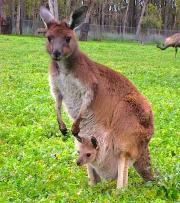Image courtesy of Subhash Chandra, Flickr
Compare-Contrast-Connect: Marsupial Mammals versus Placental Mammals
Mammals can be generally classified into three broad groups: egg-laying monotremes, marsupials, and placentals. A marsupial is a mammal that raises its newborn offspring inside an external pouch at the front or underside of their bodies. In contrast, a placental is a mammal that completes embryo development inside the mother, nourished by an organ called the placenta. Both marsupial and placental mammal groups give birth to live young. Each animal in an ecosystem occupies a specific position. Niche is the word used to describe the specific role that an organism (or a population) fills in a specific environment, including the resources it uses and its competitors for those resources.
Placental mammals account for the majority of modern mammal species alive today. Most extant marsupials can be found in Australia and South America although the fossil record shows that they were once more widespread.
| Marsupial Mammal | Niche | Photo of Mammal |
|---|---|---|
| Kangaroo | Large herbivore that forages extensively across open grasslands |
Image copyright and source
|
| Wombat | Medium-sized diurnal herbivore that feeds on grasses, constructs and dwells in extensive tunnel systems |
Image copyright and source
Image courtesy of JJ Harrison, Wikimedia Commons |
| Thylacine | Large, nocturnal fast moving predator that feeds on other mammals |
Image copyright and source
Image courtesy of E.J. Keller, Smithsonian Institution, adapted from Wikimedia Commons |
| Tasmanian Devil | Stocky nocturnal omnivore that primarily scavenges carrion and feeds on insects and plants |
Image copyright and source
Image courtesy of KeresH, Wikimedia Commons |
| Bandicoot | Small foraging omnivore that eats insects and plants, small rodents, and lizards |
Image copyright and source
Image courtesy of Aston Clulow, Flickr |
| Quoll | Small nocturnal carnivore that is an aggressive predator on small mammals, insects, and reptiles |
Image copyright and source
Image courtesy of Jade Craven, Flickr |
| Numbat | Diurnal insectivore that uses a specialized tongue to feed on ants and termites found in decaying wood |
Image copyright and source
Image courtesy of Martybugs, Wikimedia Commons |
| Dunnart | Small, nocturnal burrowing insectivore that builds nests of grass and plant material in dry areas |
Image copyright and source
Image courtesy of Bernard Dupont, Flickr |
| Placental Mammal | Niche | Photo of Mammal |
|---|---|---|
| Antelope | Large herbivore that forages extensively across open grasslands |
Image copyright and source
Image courtesy of DeusXFlorida, Flickr |
| Groundhog | Medium-sized diurnal herbivore that feeds on grasses, constructs and dwells in extensive tunnel systems |
Image copyright and source
Image courtesy of Shenandoah National Park, Flickr |
| Wolf | Large, nocturnal fast moving predator that feeds on other mammals |
Image copyright and source
Image courtesy of Tambako The Jaguar, Flickr |
| Raccoon | Stocky nocturnal omnivore that primarily scavenges carrion, and feeds on insects and plants |
Image copyright and source
Image courtesy of Nigel Swales, Flickr |
| Hedgehog | Small foraging omnivore that eats insects, plants, small rodents, and lizards |
Image copyright and source
Image courtesy of Gibe, Wikimedia Commons |
| Weasel | Small nocturnal carnivore that is an aggressive predator on small mammals, insects, and reptiles |
Image copyright and source
Image courtesy of Karunakar Rayker, Flickr |
| Anteater | Diurnal insectivore that uses a specialized tongue to feed on ants and termites found in decaying wood |
Image copyright and source
Image courtesy of Tim Hoggarth, Flickr |
| Mouse | Small, nocturnal burrowing insectivore that builds nests of grass and plant material in dry areas |
Image copyright and source
Image courtesy of Olympic National Park, Flickr |
- How are marsupial mammals different from placental mammals?
- Think of a common placental mammal not listed in SF Table 1.2 and write down its physical characteristics and ecological niche. What marsupial species might have filled this same niche?
- With the exception of Australia, marsupials largely declined or went extinct in many regions, while placental mammals dominate to this day. Provide your own explanation for this phenomenon.























